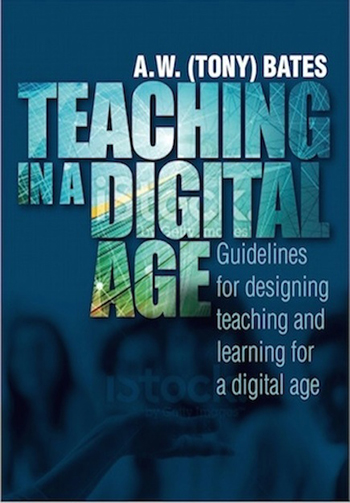Breaking Bad: Improving College and University Teaching
Published by: WCET | 4/22/2015
Tags: Course Design, Digital Learning, Distance Education, Faculty, Online Learning, Open Educational Resources, Teaching, Technology, Textbooks
Published by: WCET | 4/22/2015
Tags: Course Design, Digital Learning, Distance Education, Faculty, Online Learning, Open Educational Resources, Teaching, Technology, Textbooks
Tony Bates has had a distinguished career promoting distance learning and open learning and content initiatives around the world. Today Tony shares with us his latest book – an online, open textbook – as a resource for those teaching in our current digital age. Thanks, Tony!
or: why I wrote an open online textbook for faculty.
I’ve just published an online, open textbook, Teaching in a Digital Age, aimed at faculty, instructors and teachers. As the title suggests, it’s a guide to teaching in an age when our students are immersed in technology. My aim is to give teachers, instructors and faculty a foundational base of theory and knowledge for their teaching, no matter what changes or pressures they face.
Why this book?
The main reason I wrote the book is because I couldn’t find anything similar for college and university faculty that provides in one place all that they need to know to teach well in today’s challenging environment. In particular, I wanted to provide some guidance on the following issues faced by all instructors today:
What’s in the book?
 There are really six parts to the book.
There are really six parts to the book.
The first chapter sets the stage for the rest of the book. It looks at the key changes that are forcing teachers and instructors to reconsider their goals and methods of teaching. In particular it identifies the key knowledge and skills that students need in a digital age.
Chapters 2 through 5 on epistemology and teaching methods address the more theoretical and methodological aspects of teaching and learning in a digital age. Chapter 2 covers different views on the nature of knowledge and how these understandings of knowledge influence theories of learning and methods of teaching. Chapters 3 and 4 analyze the strengths and weaknesses of different methods of teaching ranging from solely campus-based through blended to fully online. Chapter 5 looks at the strengths and weaknesses of MOOCs. These chapters form a theoretical foundation for what follows.
The focus of Chapters 6 through 8 is on how to choose and use different media and technologies in teaching, with a particular focus on the unique pedagogical characteristics of different media. Chapter 8 ends with a set of criteria and a model for making decisions about different media and technologies for teaching.
Chapter 9 addresses the question of how to determine what mode of delivery should be used: campus-based, blended or fully online. Chapter 10 examines the potentially disruptive implications of recent developments in open content, open publishing, open data and open research. This chapter above all is a messenger of the radical changes to come to education.
Chapter 11 and Appendix 1 take two different but complementary approaches to the issue of ensuring high quality teaching in a digital age. Chapter 11 suggests nine pragmatic steps for designing and delivering quality teaching in a highly digital teaching context. Appendix 1 looks at all the necessary components of a high quality learning environment.
The last chapter very briefly examines the policy and operational support needed from schools, colleges and universities to ensure relevant and high quality teaching in a digital age.
There are also ten ‘what if’ scenarios scattered throughout the book. The purpose of the scenarios is to stimulate imagination and thinking about both our current ‘blocks’ or barriers to change, and the real and exciting possibilities of teaching in the future.
Why a free, open textbook?
Many faculty are fiercely independent and many, indeed a majority, never go to formal faculty development sessions, so I wanted something really accessible, available at a click: no credit card payments, no workshop enrolment, just a resource available at any time, as and when instructors need it.
The book in fact can be used in many different ways:
It can be easily and continually updated, and indeed I’m hoping to build communities of practice around the book so that it remains current over time.
Lastly, I’m at the end of my career. I’ve already published eleven other books through commercial publishers, and I’ve had a wonderful career in educational technology over the last 40 years, so this is somewhat of a legacy project, pulling together all my experience into one place, and making it easily available to anyone who’s interested.
My main goal though is to make college and university teaching more effective, and move it from a broken, amateurish model to a more professional one. So please spread the word, and I hope you will find the book useful, too.
 Dr. Tony Bates
Dr. Tony Bates
President and CEO,
Tony Bates Associates Ltd